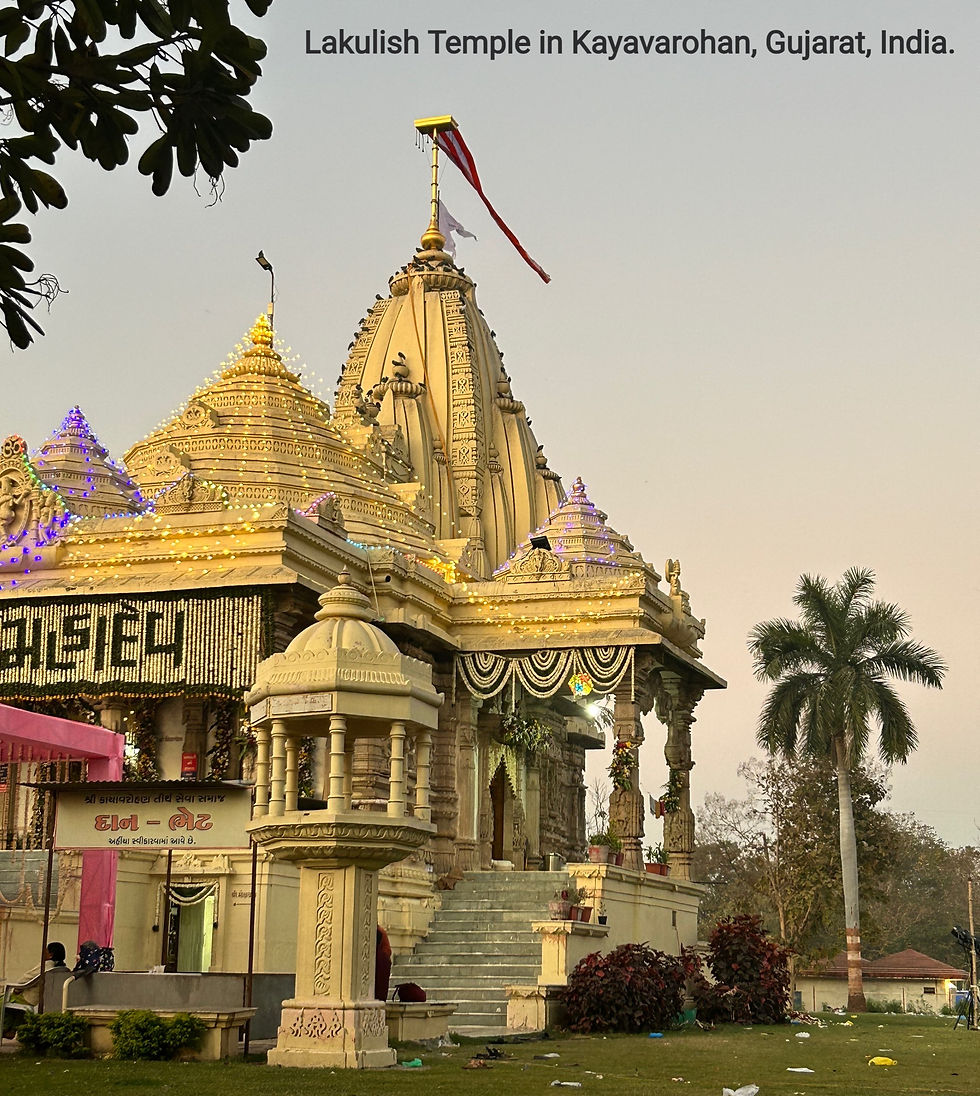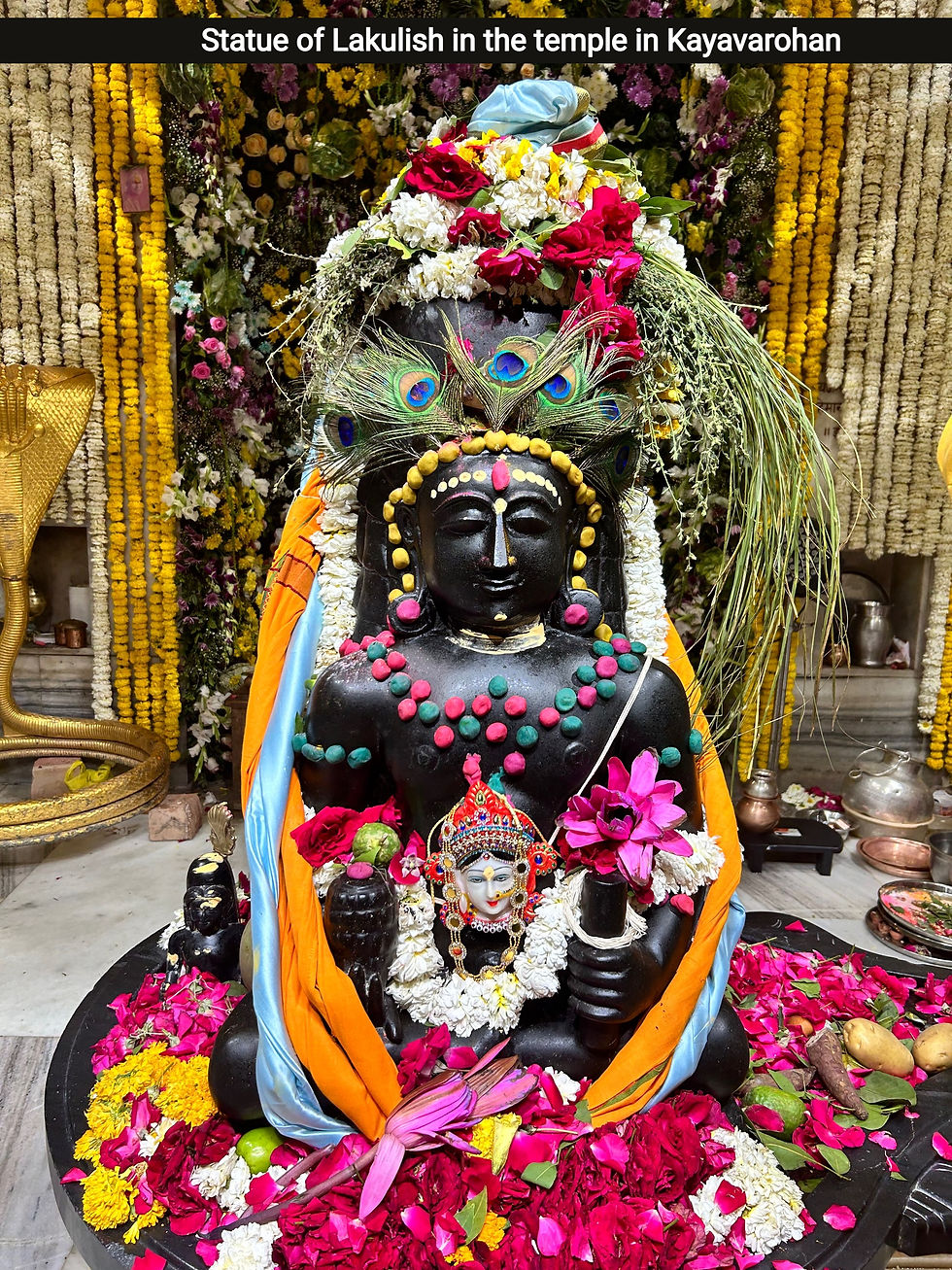Tracing the Sacred Roots: Exploring the Pashupata Yoga Tradition and Its Living Legacy
- Jessica Lohrey

- Nov 26, 2024
- 3 min read
The Pashupati Yogis, or followers of the Pashupata tradition, are among the earliest Shaivite sects devoted to Shiva, specifically in his form as Pashupati—the "Lord of Animals" or "Lord of Beings." This tradition, rooted in ancient Indian spirituality, laid the foundation for many yogic practices and philosophies still revered today.
The Pashupata tradition is also deeply connected to historical and sacred sites that embody its rich legacy. At Tree of India School of Yoga, our retreats incorporate visits to such sites, offering participants an immersive experience of yoga’s history and cultural heritage, aligning with the practices we teach.
Origins of the Pashupata Yoga Tradition

Lakulisha and Kayavarohan, Gujarat: The Pashupata tradition was founded by Lakulisha, regarded as the 28th incarnation of Lord Shiva, around the 2nd century CE. His teachings originated in Kayavarohan (Karvan) in Gujarat, a sacred site believed to be where Shiva manifested as Lakulisha. The Lakulish Temple in Kayavarohan stands as a vibrant center preserving this ancient tradition. It honors Lakulisha's contributions and serves as a pilgrimage site for devotees seeking to connect with the roots of Shaivism.
Philosophical Foundations: The tradition is captured in texts like the Pashupata Sutras and revolves around practices designed to cultivate devotion (bhakti), detachment from material existence, and ultimate liberation (moksha).

Unique Characteristics of the Pashupata Yoga Tradition
Disciplined Ascetic Practices: The Pashupata Yogis followed a rigorous path that included meditative austerities, chanting Shiva’s name, and living in cremation grounds to transcend fear and attachment.
Stages of Spiritual Practice: Practitioners progressed through stages:
Ritual devotion within a household setting.
Solitary meditation and renunciation.
Public behavior that appeared unconventional, such as laughing, crying, or dancing, symbolizing detachment from societal norms.
Shiva as Pashupati: Central to their practice was the understanding of Shiva as the supreme being who liberates all beings from the bonds of the material world.
Revival and Modern Relevance
Swami Kripalu’s Role: Swami Kripalvananda (1913–1981), a modern yogi and teacher, played a vital role in reviving the practices of the Pashupata tradition. His tantric-hatha teachings emphasized devotion, discipline, and surrender to Shiva, resonating with the core philosophies of the Pashupata Yogis.
Kayavarohan as a Living Tradition: The Lakulish Temple at Kayavarohan continues to honor and disseminate these teachings, offering a sacred space where ancient wisdom merges with contemporary practice.
The Pashupatinath Temple, Nepal

Another key site tied to this tradition is the Pashupatinath Temple in Kathmandu, Nepal, one of the holiest Shiva temples in the world. This iconic site holds immense significance for Shaivite practitioners and offers profound insights into the cultural depth of the tradition:
Historical and Spiritual Legacy: Dating back to at least the 5th century CE, this temple is a sacred space where Shiva is venerated as Pashupati, the protector of all beings.
Ritual and Pilgrimage: Pilgrims from across the world gather here, especially during Maha Shivaratri, to honor Shiva’s transformative energy.
Cremation and Liberation: Located on the banks of the Bagmati River, the temple is a focal point for Hindu cremation rituals, embodying the Shaivite philosophy of life’s impermanence and the soul’s liberation.
We will be visiting the Pashupatinath Temple in Nepla during our upcoming retreat in March 2025.

Historical Immersion in Tree of India Retreats
Our annual retreats to South Asia are designed to provide participants with a deep, transformative experience that combines yoga practice with historical and spiritual immersion. For students and practitioners of the Pashupata-influenced tantric-hatha yoga tradition taught at Tree of India School of Yoga, visiting sites like the Lakulish Temple in Kayavarohan and the Pashupatinath Temple is not only inspiring but essential to understanding the context and depth of their practice.
These sacred locations are more than historical landmarks—they are living embodiments of the wisdom, devotion, and transformative power of the yogic path.
By integrating these sites into our retreats, we honor the timeless lineage of yoga while deepening participants’ appreciation for its spiritual and cultural roots. This connection to history allows students to experience yoga not merely as a physical practice but as a profound journey into the heart of ancient wisdom and spiritual awakening.



Comments